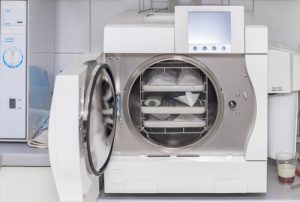In medical and laboratory settings, ensuring the sterility of equipment is paramount. One of the primary tools in achieving this is the autoclave. But how can we be certain that this machine performs its job effectively? Enter the world of autoclave validation. This process is not just a mere formality but a critical step in guaranteeing patient and user safety. If you’ve ever wondered about the intricacies of this validation and why it’s so vital, you’re in the right place.
Join us as we unravel the significance and the methods behind autoclave validation, a topic that might seem technical but is crucial for every healthcare and laboratory professional.
Why is autoclave validation important?
 In the medical and laboratory sectors, the importance of sterilisation cannot be overstated. Autoclaves, which utilise steam under pressure to sterilise equipment, play a pivotal role in this process. However, merely operating an autoclave doesn’t guarantee the desired outcome; this is where the significance of autoclave validation comes into play.
In the medical and laboratory sectors, the importance of sterilisation cannot be overstated. Autoclaves, which utilise steam under pressure to sterilise equipment, play a pivotal role in this process. However, merely operating an autoclave doesn’t guarantee the desired outcome; this is where the significance of autoclave validation comes into play.
- Australian Standards Compliance: Adhering to the Australian standards is not just a matter of regulatory compliance but also ensures that the sterilisation process is effective and safe. Autoclave validation ensures that these standards are consistently met.
- Ensuring Sterilisation: The use of biological indicators and high-temperature data loggers during the validation process helps in confirming that the autoclave chamber reaches the correct values of temperature and pressure, ensuring effective sterilisation.
- Equipment Longevity: Regular validation can identify issues with the autoclave, potentially reducing service and maintenance costs in the long run. By ensuring the equipment operates within manufacturers’ specifications, its lifespan can be extended.
- Safety and Risk Management: Inadequately sterilised surgical instruments can pose a significant patient risk. Autoclave validation ensures that every cycle is sterilised correctly, minimising the risk of infections or complications.
- Regulatory Adherence: In many regions, adhering to state health regulations requires mandatory annual validation of autoclaves. This process ensures that medical practices remain compliant and avoid potential penalties.
- Cost Efficiency: While costs might be associated with the validation service, these are outweighed by the potential hidden costs of using improperly sterilised equipment or facing regulatory fines. Furthermore, maintenance packages can offer cost-effective solutions for regular validations.
- Trust and Reputation: For medical and laboratory facilities, reputation is paramount. Ensuring that autoclaves are validated and operate at peak efficiency can bolster trust among patients and stakeholders, knowing that safety and accuracy are prioritised.
In essence, autoclave validation is not just a procedural necessity but a cornerstone of effective and safe medical and laboratory operations. By ensuring that the sterilisation process is consistently effective, facilities can ensure the safety of their patients and the longevity of their equipment.
Autoclave validation process
Autoclaves are indispensable in medical, dental, and laboratory settings, ensuring that equipment and instruments are free from microorganisms and safe for use. However, the mere presence of an autoclave doesn’t guarantee effective sterilisation. This is where the autoclave validation process becomes crucial, ensuring that the equipment operates optimally and adheres to the stringent standards for sterilisation.
- Adherence to Australian Standards: The validation process is designed in line with Australian standards, ensuring that autoclaves operate within the stipulated parameters, guaranteeing effective sterilisation.
- Temperature and Pressure Monitoring: Using high-temperature data loggers, the validation process ensures that the autoclave chamber reaches and maintains the correct temperature and pressure levels. This is vital for the effective killing of microorganisms.
- Use of Biological Indicators: These are introduced into the autoclave and are designed to be more resilient than the toughest microorganisms. If the autoclave successfully neutralises these indicators, it’s a strong sign of effective sterilisation.
- Equipment Calibration: The validation process includes the calibration of the autoclave, ensuring its readings are accurate. Calibrated equipment ensures that the autoclave operates within the manufacturer’s specifications.
- Load Testing: Different loads can affect the autoclave’s efficiency. The validation process tests various load types to ensure consistent sterilisation, regardless of content.
- Cycle Verification: Every sterilisation cycle is verified to meet the required standards. This includes checking steam penetration and ensuring no cold spot remains in the autoclave chamber.
- Documentation and Reporting: A crucial part of the validation process is documenting all findings. This not only serves as a record for regulatory purposes but also helps in identifying potential issues that require attention in the future.
In summary, the autoclave validation process is a comprehensive assessment of an autoclave’s functionality and efficiency. It ensures that the validated equipment not only meets regulatory standards but also provides the highest level of sterilisation, ensuring safety and efficacy in medical and laboratory environments.
How often should an autoclave be validated?
An autoclave ensures sterilisation in medical, dental, other service and laboratory settings. To maintain its efficacy and adhere to Australian standards, an autoclave must undergo validation regularly.
Typically, validation should be conducted at least annually. However, in high-use environments or when the autoclave is critical to operations, more frequent validations might be recommended. Regular validation ensures that the autoclave operates optimally, providing consistent and effective sterilisation, and meets regulatory requirements.
Autoclave validation service and maintenance costs
Autoclaves are indispensable in medical, dental, and laboratory environments, ensuring that instruments and equipment are sterilised effectively. However, to guarantee their consistent performance and adherence to Australian standards, regular test and validation is essential.
- Validation Service: The autoclave validation process ensures the equipment operates according to manufacturers’ specifications and state health regulations. This service examines steam penetration, temperature and pressure consistency, and the effectiveness of the sterilisation process. Often, biological indicators are used to confirm the autoclave’s ability to eliminate microbial life.
- Maintenance Costs: Beyond validation, autoclaves require regular maintenance to ensure longevity and optimal performance. These costs can encompass parts replacement, recalibration, and addressing wear and tear. Maintenance packages might be offered by service providers, which can be more cost-effective than individual service calls.
- Hidden Costs: It’s crucial to be aware of potential hidden costs. For instance, if an autoclave isn’t sterilising correctly due to a lapse in validation or maintenance, there could be risks to patient health, leading to potential liabilities.
- Australian Standard Compliance: Adhering to Australian standards is not just about ensuring effective sterilisation. It’s a mandatory annual requirement, and non-compliance can result in penalties. Regular validation and maintenance, while having associated costs, ensure compliance and can save institutions from more significant financial burdens in the long run.
In conclusion, while costs are associated with the calibration, validation service and maintenance of autoclaves, they are investments in ensuring patient safety, equipment longevity, and regulatory compliance.
Conclusion
In sterilisation, the significance of autoclave validation cannot be understated. Ensuring equipment operates at its peak and adheres to stringent standards is paramount for safety and compliance. As we’ve delved into the intricacies of this process, it’s evident that regular autoclave validation is an investment in quality, safety, and peace of mind. Whether you’re in the medical, dental, or laboratory sector, prioritising this validation is a testament to a commitment to excellence and patient care.
For a seamless and professional autoclave validation experience, don’t hesitate to reach out. Ensure your equipment meets the highest standards of safety and efficiency. Call us today at (02) 8880 7813 and let MELAG Autoclave guide you and validate the process with expertise and precision. Your commitment to excellence deserves nothing less.
References
Autoclave Validation – Environmental Health and Safety
https://www.umaryland.edu/ehs/research-safety/biosafety/autoclave-use-and-quality-assurance-program/autoclave-validation/
Autoclave Validation for Biohazardous Waste Treatment
https://biosafety.utk.edu/biosafety-program/waste/autoclave-validation-for-biohazardous-waste-treatment/
Validation of Autoclave Protocols for Successful Decontamination of Category A Medical Waste Generated from Care of Patients with Serious Communicable Diseases
https://www.ncbi.nlm.nih.gov/pmc/articles/PMC5277525/
Process Validation: Moist Heat Sterilisation for Pharmaceuticals
https://www.canada.ca/en/health-canada/services/drugs-health-products/compliance-enforcement/good-manufacturing-practices/validation/process-validation-moist-heat-sterilization-pharmaceuticals.html
Autoclave Waste and Validation
https://drs.illinois.edu/Page/Waste/AutoclaveWasteAndValidation


